Abstract
We have been living in the digital age for decades, and the impact of technology is seen in all aspects of our lives, however, when Covid-19 pandemic began and spread throughout the world, during the first year, over 100 countries worldwide had instituted either a full or partial lockdown. In the new situation, the use of technology to facilitate communication and the provision of information was no longer a recommendation but became necessary and inevitable. Education systems, as well as other sectors, were severely affected by the pandemic. While investments are directed to develop infrastructure of online communication and preparing high-quality devices and software, preparing relevant content for online platforms remains a challenge. The method of content creation needs to be adapted with advanced technologies. Therefore, this paper proposes implementing technology integration to enhance the quality of content through technological pedagogical content design (TPCD). TPCD utilizes pedagogical science findings for using technologies to create, organize, and present the content. The systematic instructions for applying TPCD include seven steps: 1) specifying the purpose of content transfer, 2) selecting valid and trustworthy resources, 3) concept mapping, 4) respecting user’s mind, 5) material selection or creation, 6) organizing the content, and 7) organizing the content presentation.
Keywords: Content quality, TPCD, technology integration, user-centered design
Introduction
Covid-19 Pandemic is possibly the biggest crisis after World War II in terms of its global effects on all aspects of life. The constraints caused by this crisis have affected people's lifestyles and health (Park et al., 2021). During the pandemic, many organizations limited their communication from face-to-face communication to online or telephone communication, and the role of technology and the Internet changed from a facilitator to a necessity in modern societies (Kinnunen & Georgescu, 2020).
Education systems, as well as other sectors, were severely affected by the crisis. Nearly 1.6 billion learners in more than 190 countries on all continents have been affected by the closure of universities and schools during the pandemic (De Giusti, 2020). Results of the studies show that the educational systems of many countries were not well equipped for shifting from traditional education to e-learning at least during the first months of Covid-19 restrictions (Dorn et al., 2020). The global lockdown of educational institutes raised many challenges for administers, teachers, students, and their parents. Teachers’ knowledge and experiences in accessing the Internet and the use of technology ares reported as a significant problem for the transition from traditional education to e-learning in many studies (Hosseini et al., in press (c); Sari & Nayır, 2020; Mansur et al., 2021). Likewise, Internet access has been reported challenging for students in many developing countries. Indonesian students were frustrated and complaining about poor connection, preparing phone credit, and searching a place to find the better signal for their connections (Muslimin & Harintama, 2020). Lestiyanawati (2020) categorized the e-learning problems that arose during the pandemic into: “the teachers’ disability in accessing technology, school facilities in supporting e-learning, the difficulties in explaining the material, students’ limitation in accessing Internet, students’ economically disadvantaged family background, and parents’ support system”.
According to research findings, the quality of educational systems in the pandemic period depends on (1) increasing the competency of teachers for integrating technology, and (2) providing internet access, technology equipment and upgrading online learning facilities (Dubois et al., 2021; Kinnunen & Georgescu, 2020; Lestiyanawati, 2020; Mansur et al., 2021).
Preparing teachers for technology integration has been recommended by many educational technology scientists and researchers. The term of technology integration was introduced by Morton (1996) for selecting and using technology based on the teaching methods and content and not as an isolated or separate tool. Accordingly, many theories, models and strategies have been identified for technology integration (Hosseini & Azimi, 2012). One of the advanced and known models of technology integration is Technological Pedagogical Content Knowledge (TPACK). Mishra and Koehler (2006) introduced TPACK as the required knowledge for teacher to use technology based on content and pedagogy (Figure 1). Based on TPACK, learning ICT isolated from pedagogy and content is not adequate for effective teaching and teachers need to know how to integrate technology into their teaching.
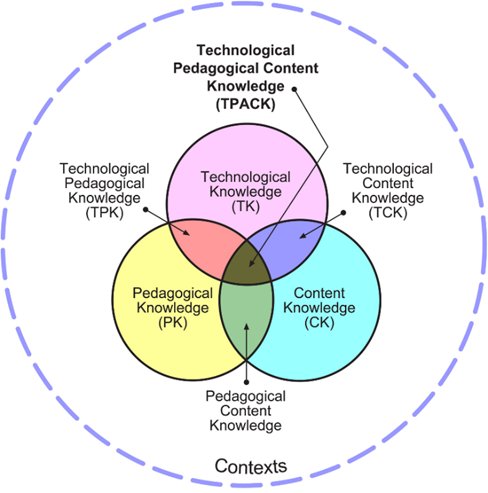
In the last decade, many researchers have applied different approaches for developing TPACK in teacher education programs such as collaborative learning (Zhang et al., 2019), directed instructions (Hosseini, 2016a), and problem-based learning (Niess, 2018). Existing studies and practices on TPACK have emphasized on developing abilities of in-service and preservice teachers (Chai & Koh, 2017; Hosseini & Tee, 2011, Hosseini, 2016b, 2016c; Tanak, 2018). These studies have shown the potential of TPC knowledge to increase the quality of teaching and learning in virtual, blended learning and face-to-face educational environments. The rapid growth of technology causes that TPACK cannot prescribe a similar technology usage, even for the same content and context. Therefore, uncertainties regarding the use of TPACK in practice act as a barrier for innovative researchers, and despite all these efforts, during the lockdown teachers showed they were not well prepared to integrate technology into their teaching. This paper proposes a practical model for integration of technology and pedagogy into content to enhance the quality of content. It uses TPACK knowledge for creating, selecting, and organizing the content through a user-centered design in digital educational and non-educational settings.
Problem Statement
With the extraordinary growth of knowledge and its resource inequality (Chatterjee, 2021), selecting the content for educators or transmitters is becoming more difficult. What is the content? Content is defined as “the things that are held or included in something. It can be the amount of a particular constituent occurring in a substance or list of the chapters or sections given at the front of a book or periodical or the material dealt with in a speech, literary work, etc. as distinct from its form or style or information made available by a website or other electronic medium” (https://www.lexico.com). What distinguishes the concept of content from similar concepts such as subject, knowledge, information or material is that content can be a selected part of a subject, information, or material based on the particular purpose. For example, mathematics is a subject for teaching, and the selected sections determine the content of a mathematics book. The subjects, knowledge, information, and materials are the sources of content that have no limit and content is always a limited part of them that can be transferred through many tools and methods.
While investments and attentions are toward developing infrastructure of online learning and preparing high-quality devices and software for users, information and content cannot be transferred if it is not well selected, organized, and integrated with technology. Hence, this paper addresses the issue of how to integrate technology with pedagogical perspective to enhance the quality of content.
Research Questions
Given the volume of information, the most challenging decisions are to answer the following questions: What are the criteria to create or select the content? How to organize and transfer the content to reach recipients?
Since this paper proposes a technology integration design model for enhancing the quality of content, the main question is how the proposed model is increasing the quality of content through technology integration.
Purpose of the Study
The purpose of this study is to define a model and instruction for integrating technology to increase the quality of online content. The proposed Technology Pedagogical Content Design (TPCD) model can be used in both educational and non-educational environments to provide instructions for the preparation and transmission of content through technology.
Research Methods
This study proposes a technology integration model to increase content quality through a design study. “Design studies are one particular form of the more general category of problem-driven research, where the goal is to work with real users to solve their real-world problems” (Sedlmair et al., 2012, p. 2432). In a design study, visual researchers define a real-world problem and design a visualization system for solving the problem. Likewise, this paper suggests TPCD as an appropriate model that offers a systematic instructional design for integrating technology and content and pedagogy to enhance the quality of digital services in educational and non-educational settings (Hosseini & Kinnunen, 2021; Hosseini et al., 2021, Kinnunen et al., 2021). TPCD originates from Technological Pedagogical Content Knowledge. While TPACK defines the teachers’ knowledge for integrating technology, TPCD offers strategies and steps for designing a technology (Figure 2).
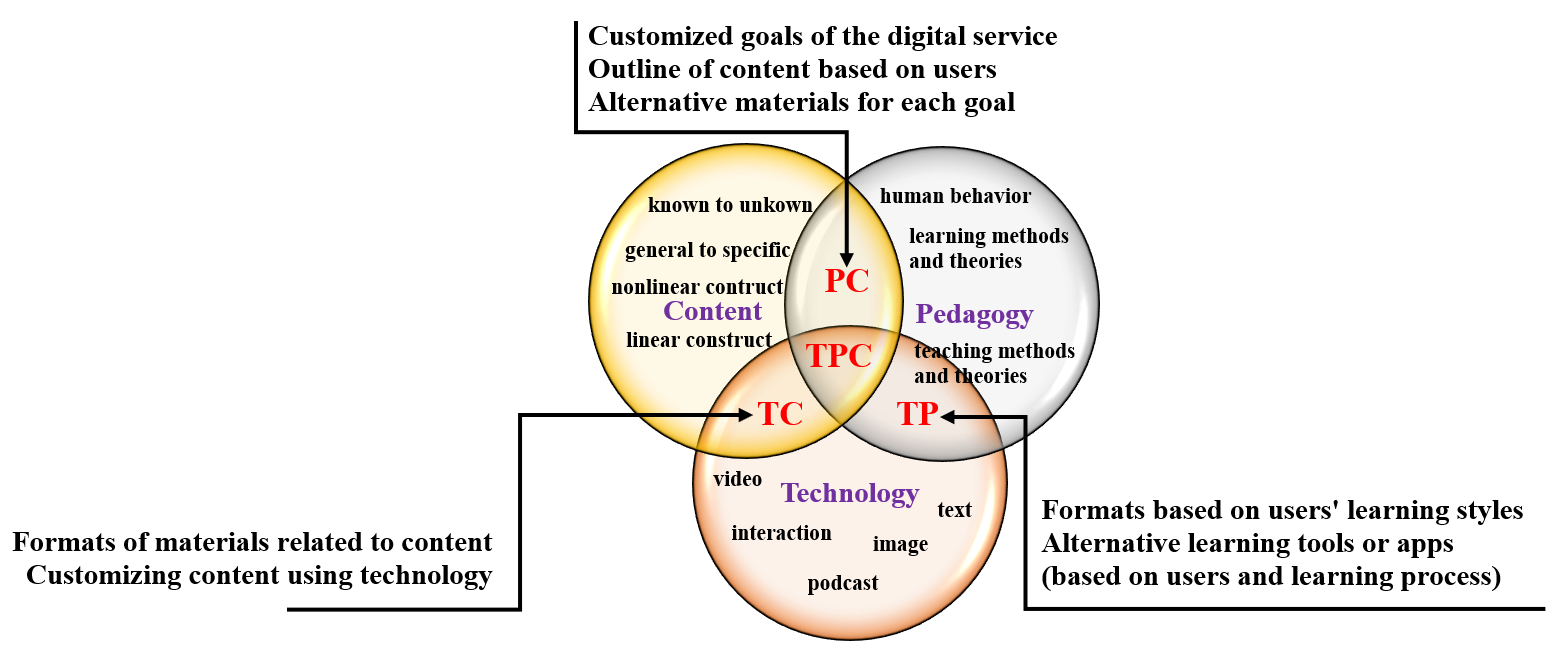
TPCD has three main components: technology, pedagogy, and content. Technology includes the textual, visual, and interactive technology. Pedagogy includes the principles that help the instructor or designer know the users’ characteristics and quality and the factors that influence the transfer or transforming cognitive knowledge, attitude, and skills of users. Content is a purposeful selected part of knowledge or subject. TPCD design likewise TPACK has three sub-integrative components including pedagogical content, technological content, and technological pedagogy. Each of these components offers some limited integration possibilities. TPC integration takes place when the technology is used for an organized content based on pedagogical rules and principles.
Findings
Based on TPCD, the designer cannot select the content regardless of pedagogy and technology. The systematic instructions of technological pedagogical content design include the seven steps presented in sections 6.1-6.7.
Specifying the Purpose of Content Transfer
Since the knowledge about each subject is increasingly unlimited to determine the content (selecting a part of knowledge) the designer needs to specify the purpose of content transfer. Based on pedagogical science, the best way to define the purpose of content is to determine “what the user of technology (or learner) is expected to do or know by receiving the content”. Currently, many technology designs’ purposes are based on the content title or subject while the field and level of a pedagogical goal is also essential for selecting the content (Hosseini et al., in press (b)). For instance, the main goal of an educational website might be defined as “teaching/learning plants reproduction”. This aim is good to limit the knowledge for selecting the content, but it doesn’t specify whether users (learners) are expected to just know the different methods of reproduction, or they should be able to reproduce plants themselves. Based on pedagogical science specifying the purpose should be defined clear, for instance; “the users/learners will know the different methods of plants reproductions” which shows it is not expected that users/learners do any more actual activities in reproducing plants. In another example, when the aim of the content is encouraging the users to buy a product, the content can be very different, when the aim is to help users know how to use the product. In both situations, the same product is the title but in the first situation focus of the content is changing the attitude of users so that the advantages of the products are explained, and in the second situation the content includes the instruction for using the product. The objective goals are designed by compromising the aim of the content creator/designer and the aim of the users considering the characteristics of users. Bloom taxonomy has a guide for determining the aims’ domain and levels based on users’ activities and actions (Hosseini et al., in press (b)).
Selecting Valid and Trustworthy Resources
To avoid mis- and disinformation, the content should be selected from valid resources. Subject experts in a technology design team are responsible for preparing valid, reliable, and trusted content for fulfilling the purpose of content transfer. Ethical issues should be considered to create the content to increase trustworthy of the content.
Concept Mapping
Each subject or knowledge has a structure that may be linear or nonlinear. The structure of a subject is important in organizing the content. This structure can be drawn in a concept map or mind map. Currently, there is some software for drawing a mind map for dividing the content. Some examples of sequential design linear content are discretional steps, problem-solving sequence, storytelling, and historical sequences. Some examples of nonlinear sequences are branching stories and parallel content. For some subjects, the structure of the content is strict and unavoidable like learning addition and before multiplication and division in mathematics. But for instance, for learning plant reproducing methods, the content can be organized in different ways. Later, the important criteria to select the suitable way for organizing the content are discussed.
Respecting the User’s Mind
Educators and technology designers, both are aware of the importance of considering the recipients’ characteristics to enhance the quality of communication. Further, efforts to maximize user engagement with the content through technology have increased. user-centered design and flipping classrooms are two known examples of focusing on the users’ or learner’s activity. However, finding the most important criteria in users (or learners) to maximize the quality of content transferring has been always in discussion.
Pedagogical knowledge can guide the content creator/developer to understand and predict users’ minds. The educational psychology theories, developmental psychological theories, and learning theories help content creator/developer to understand users’ characteristics, the influences of situations and individual conditions, and brain function to select and organize technology and content. User experience research is a known discipline to study a user's mind and taste and select the content and technology tools, however, most user experience researchers are focusing more on general behavioral science and psychology than cognitive and pedagogical perspectives.
Demographic information about users (learners) such as age, gender, educational status, etc. is usually collected to understand some parts of needs and expectations and favourite taste of users by user experience researchers. Developmental psychology theories guide designers to realize and predict these needs and expectations and functions of brain such as strengths and weaknesses in memorizing, reasonable thinking, and problem-solving in each stage of physiological, cognitive, and social growth. Further, understanding a user’s culture and cognitive, affective and skill backgrounds guide the content creator/developer to select the content, while avoiding duplication or lack of content.
Materials Selection or Creation
The content can include different formats such as text, image, chart, graph, audio, video, games, etc. The diversity of materials is as broad as the knowledge itself. Internet and web 2.0 are making it unlimited. However, sometimes the content creator/developer (or designer) needs to produce some materials exactly based on the accurate goals. The content developer can select materials from existing sources or customize some of them to get fit with the accurate goals. If those options are not possible, the required format of content should be produced. In fact, the most important duties of a content creator/developer in designing technology include selecting, customizing, creating, and organizing the content.
Organizing the Content
The concept of content organizing is tied to the concept of presenting the content materials on different pages of a website. In fact, since the content is a combination of text and visual materials (images, videos, etc.), separating the organization of content and presenting it is not easy. This article suggests organizing the content based on psychological and pedagogical principles and the structure of content itself considering the users' characteristics before presenting it on a digital platform. This is an integration of pedagogy and content in the TPCD model. Technological tools are integrated into pedagogical content (TP) in the next step. Therefore, in this step, the content is organized based on pedagogical principles and users’ priorities.
The structure of the content can be linear or nonlinear sequences. For linear structure, at least one of the following criteria is usually considered: description list, problem/solution, known to unknown, simple to complex, concrete to abstract, analysis to synthesis, specific to general, from empirical to rational, induction to deduction, psychological to logical, actual to a representative, whole to parts, and definite to indefinite. Some methods of nonlinear sequences include access to background content, access to optional advanced content, around a common introduction, parallel content, and creating a branching story for impact (Hosseini & Okkonen, 2022).
Further, Malamed (2021), an e-learning coach, suggests 10 different ways for organizing the content: 1) Alphabetical, which is simple and easy to search among topics; 2) Categorical is suitable when there is no hierarchy, prerequisite, or sequence in the structure of content; 3) Cause and effect method is suggested when there are some problems and solutions in the structure of the content; 4) Inherent structure when the content organization is following the content structure like dividing based on the time of events or locations; 5) Order of importance, which is appropriate for a flat structure with no hierarchy that can be from the most important to the last or opposite; 6) Simple to complex, which enhances the user confidence; 7) Sequential is when the structure of content includes some steps or defines a process; 8) Spiral when the structure of the content is moving to be more detailed and complex level each time; 9) Subordinate to a higher level that is effective for hierarchical content structure; 10) Whole to parts to make sense of information by presenting a big picture and then going to detail (Malamed, 2021). The construct of content and user characteristics and demand are important factors for deciding on the content organization.
Organizing the Presentation of the Content
Using psychological principles for organizing and presenting the content is helping users find the receive the points the way that is planned by content developers. Gestalt principles are the result of a group's work of German psychologists in the 1920s. They developed a theory to explain how the human brain attempts to simplify and organize complex images to understand the environment by giving structure, logic, and pattern to designs. some of Gestalt principles include similarity, continuity, proximity, common fate, element Connectedness, common region, figure-ground, closure, focal point, experience, and symmetry (Figure 3). Gestalt principles have been used for organizing and presenting the content to direct users’ minds on websites (Kapllani & Elmimouni, 2020). All figures and tables should be referred in the text and numbered in the order in which they are mentioned.
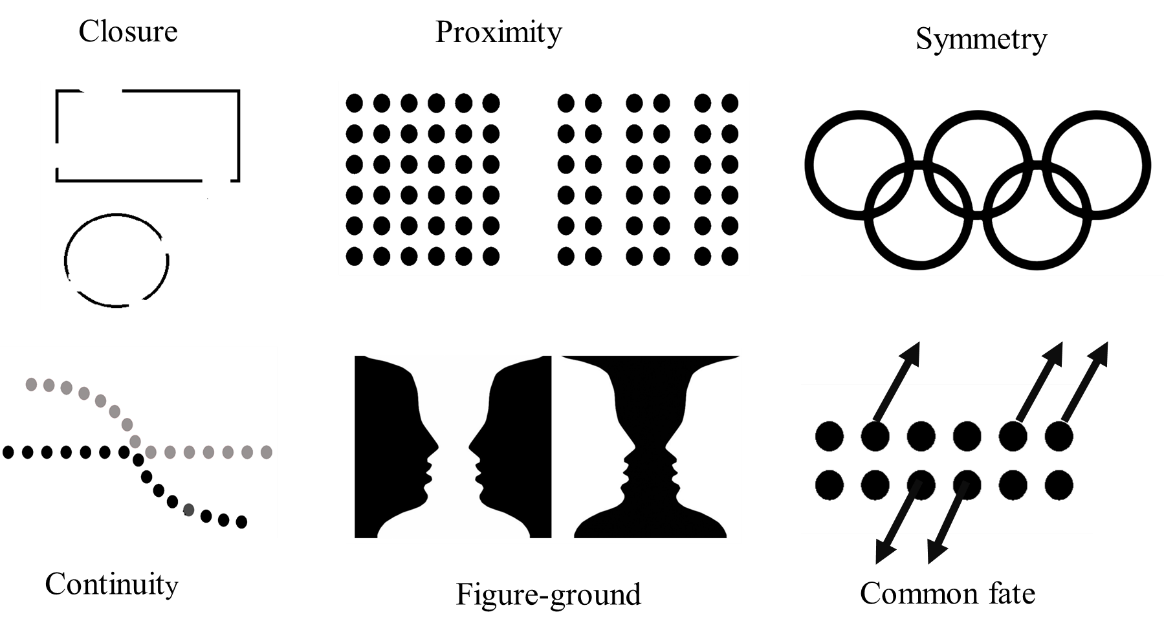
Idler (2012) presents nine guidelines that help to optimize the content organization (in presenting) for all the users of a website: 1) Define clear information of structure by defining the target group and their goal; 2) Start with critical and core content by displaying them on the top of the page; 3) Group the related content in a logical and objective way; 4) Show only what’s relevant by keeping the content simple; 5) Show everything that’s relevant; 6) Consider different audiences but start with the most relevant user; 7) Offer different entry points spatially when the users are very different; 8) Offer customization so that users select what is important and what is not; 9) Test before implementation. Baker (2014) introduces findability as the most important issue in content presenting and believes classification, relationships, and stickiness of the content are three important components to the content organization to increase findability. Stickiness refers to how readers get back to the content. Classification creates an order, and the content pieces and relationships refer to connections between one piece of content and another. Links can be complex and irregular (Figure 4).
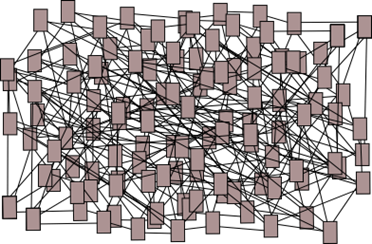
Relationships among content pieces can be presented in many ways. Deshpande (2012) suggests many visual organizations of the content for moving from each page to other relevant pages on the website. He suggests 7 ways for referencing the pages, including 1) tagging, 2) grouping, 3) recommending, 4) faceted navigation sidebar, 5) Google trend histograms, 6) creating topic pages, and 7) topic map.
For Presenting the content based on TPCD, the content is divided into small pieces of content named as Learning Content Objects (LCOs) that have clear or objective learning goals and materials that can be text, image, etc., or a combination of them (Figure 5). LCOs are linked together based on the sequence of content structure on the pages. (Hosseini et al., 2022). The Content presenting is a dynamic process that needs to be updated based on the daily demands of users. Attention to the user characteristics and providing alternative material, and multiple entries enhance the findability of the content.
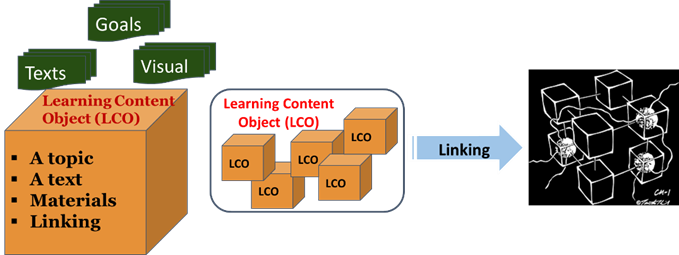
TPCD proposes some fundamental rules for 1) presenting reasonable classification in titles, categories, and descriptions; 2) simplicity (e.g., in colour, fonts, text, and pictures); 3) meaningfulness of items; 4) minimality; 5) clear instructions; and 6) feedback facilities.
Discussion
Technology is under constant development and its usage is growing fast while most methods of creating and organizing the content have hard time to keep up. The undergoing change makes people struggle for adapting themselves to new technologies: while users are confused with new technologies, designers are hasty to make changes, which may be raw still. Recently, engineers and technology designers have made efforts to consider user demands and reduce the challenges which hinder the use of technology. They are employing human science theories to understand users better and move toward user-centered design. However, on the one hand, the complexity of human mind and the speed of technology advancement, and the daily change with constantly increasing content, on the other hand, make it more difficult and complex to present a model of using technology to transfer content. This article proposes Technological Pedagogical Content Design (TPCD) as an integrative method for the effective use of technology for transferring the content. Integrating pedagogy, content, and technology is a process and cannot be discussed separately. This article attempted to offer the instructions which can guide the content creators/designers/developers forward in creating and updating the content. Each level of integration has been summarized in Figure 6.
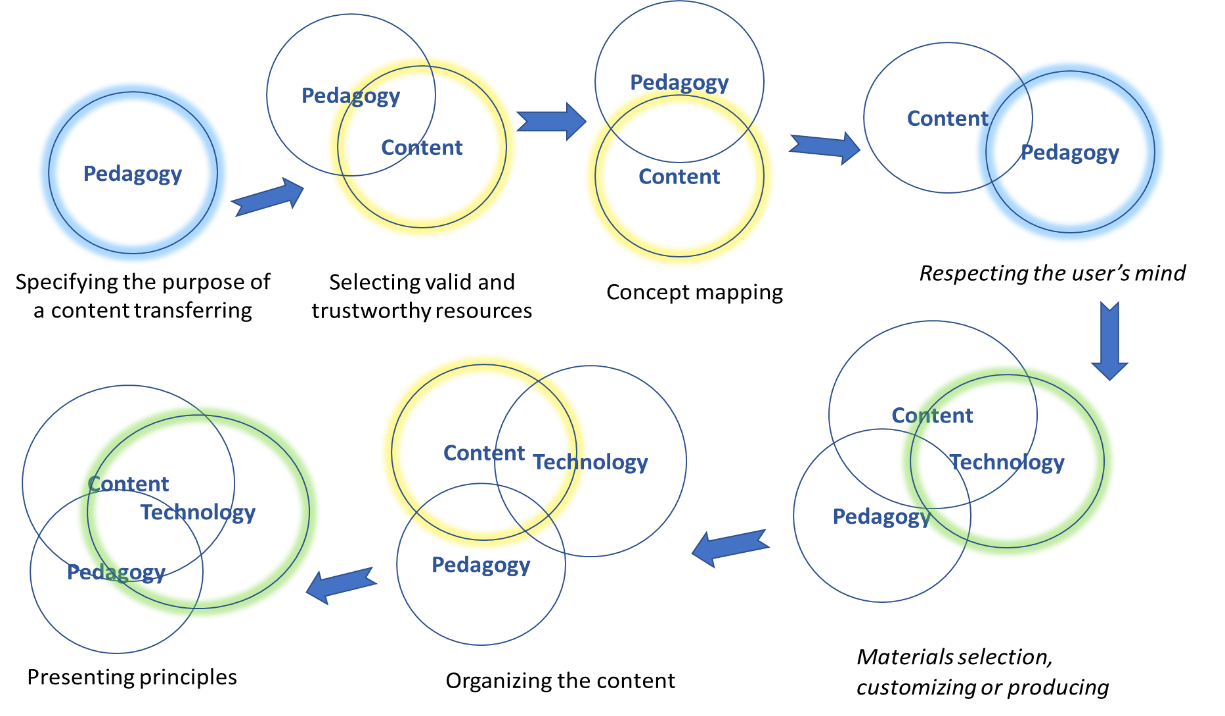
The technology design process starts by defining the objective goals that are emerged from the transmitter aim (organization or company) and user demands. The goal is analyzed in pedagogical ways to determine which content should be created or selected (Pedagogy). Content, which covers the goals is selected from valid resources (Pedagogical Content with a focus on content). Drawing a concept map clarifies the connection between content and goals (Pedagogical Content). Educational psychology and learning theories in pedagogical science are employed to fit the content with the users’ characteristics, minds, and learning styles (Pedagogical Content). Content is created in different text and visual formats so that it covers most users (Technological Content). Content in different formats is organized and presented based on pedagogical rules and users’ priorities and demands (Technological Pedagogical Content).
Conclusion
The different industries and organizations are investing huge amounts to lead the minds of their customers or other target groups toward the hidden and overt purposes softly, accurately, subtly, and precisely using technological solutions. However, if the content is not well created, selected, organized, and integrated with technology, it would not be transferred to users successfully and the made investments in technology may turn out wasted sunk costs. Obviously, modern cities need advanced technologies in hardware, software, and digital tools for facilitating communication and information transfer. Covid-19 pandemic has shown, with the growth of technology, that still many educational and non-educational environments have trouble to reach their users effectively. The lack of the required technology infrastructure on the one hand and the unpreparedness of people, specifically, the employees of private and public organizations, on the other hand, have caused various failures in many countries. In the modern cities of developed countries, where technological infrastructure is a necessity, the inadequacy of contents on many corporate websites has been perceived problematic by people. Developed countries and modern cities need to employ advanced methods for enhancing the quality of content through adapting with advanced technology and integrating technology into content. In this process, pedagogy is a promising method to increase the quality of content.
The technological pedagogical content design, TPCD, offers instructions for integrating technology into content built on pedagogical theories and principles. This applies to educational and non-educational settings. Further, updating the content, and taking advantage of the latest pedagogical research finding, along with utilizing advanced technologies are essential to increase the usability and findability of content. The authors have discussed some practical examples and cases, and the role of TPCD in designing a business association’s website (Hosseini et al., in press (b)) and public digital services (Hosseini et al., in press (a)). Different context-specific case studies, in educational or non-educational, private (cf., Hosseini et al., 2022; Kinnunen et al., 2021) or public (cf., Hosseini et al., in press (a)) fields, are expected to be valuable for developing the proposed approach further.
References
Baker, M. (2014). Three components of content organization. Retrieved from http://everypageispageone.com/2014/08/11/three-components-of-content-organization/
Chai, C. S., & Koh, J. H. L. (2017). Changing teachers’ TPACK and design beliefs through the Scaffolded TPACK Lesson Design Model (STLDM). Learning: research and Practice, 3(2), 114-129. DOI:
Chatterjee, S. (2021). Knowledge Resource Inequality. IUP Journal of Knowledge Management, 19(3), 49-75.
De Giusti, A. (2020). Policy Brief: Education during COVID-19 and beyond. Revista Iberoamericana de Tecnología En Educación y Educación En Tecnología, 26. DOI:
Deshpande, P. (2012, September 19). 7 Ways to Organize Your Content for Curation. Content Marketing Institute. https://contentmarketinginstitute.com/2012/09/7-ways-to-organize-your-content-for-curation/
Dorn, E., Hancock, B., Sarakatsannis, J., & Viruleg, E. (2020). COVID-19 and student learning in the United States: The hurt could last a lifetime. McKinsey & Company.
Dubois, E., Bright, D., & Laforce, S. (2021). Educating Minoritized Students in the United States during COVID-19: How Technology Can be Both the Problem and the Solution. IT Professional, 23(2), 12-18. DOI:
Hosseini, Z. (2016a). The Usage of Constructivism to Enhance Technology Integration Knowledge. Journal of Technology of Education- Shahid Rajayee Teacher Training University, 10(2), 155-164. DOI: 10.22061/tej.2015.439
Hosseini, Z. (2016b). The Comparison between the Effect of Constructivism and Directed Instruction on Student Teachers’ Technology Integration. New Educational Approach. Approved Journal of University of Isfahan, 10(2), 21-40. https://nea.ui.ac.ir/article_20903.html?lang=en
Hosseini, Z. (2016c). The potential of directed instruction to teach effectively technology usage. World Journal on Educational Technology, 8(3), 172-179. http://sproc.org/ojs/index.php/wjet/article/view/553/pdf
Hosseini, Z., & Azimi, M. (2012). Integration of Computer Technology in Teaching and Learning Models and Strategies. In Proceeding of 6th International Symposium on Advances in Science and Technology. SAS Tech 2012 (pp. 24-25). Publisher Malaysia. https://www.researchgate.net/publication/260384752
Hosseini, Z., & Kinnunen, J. (2021). Integration of Pedagogy into Technology: A Practical Paradigm. In Proceedings of the International Conference on Education and New Developments. International Conference on Education and New Developments (pp. 450-410). inScience Press.
Hosseini, Z., & Okkonen, J. (2022) Web-Based Learning for Cultural Adaptation: Constructing a Digital Portal for Persian Speaking Immigrants in Finland. In K. Arai (Ed.), Intelligent Computing. Lecture Notes in Networks and System (Vol. 283). Springer, Cham. https://doi.org/10.1007/978-3-030-80119-9_62
Hosseini, Z., & Tee, M. Y. (2011). Development of TPCK through project–based learning. In Proceedings of1st International Conference on World-Class Networking for World-Class Education. ICWEd 2011. http://eprints.um.edu.my/13579/1/0001.pdf
Hosseini, Z., Hytönen, K., & Kinnunen, J. (2021). Introducing Technological Pedagogical Content Design: A model for transforming knowledge into practice. Knowledge Management & E-Learning: An International Journal (KM&EL), 13(4).
Hosseini, Z., Hytönen, K., & Kinnunen, J. (in press (a)). The Pedagogical Aspect of Human-Computer Interaction in Designing: Pragmatic Examples. In Proceedings of the International Conference on Intelligent Vison and Computing. ICIVC. Springer.
Hosseini, Z., Hytönen, K., & Kinnunen, J. (in press (b)). Technological Pedagogical Content Design (TPCD) for User-Centered Website: A Case Study in Finland (in review).
Hosseini, Z., Kinnunen, J., & Hytönen, K. (2022). Utilizing Technological Pedagogical Content (TPC) for Designing Public Service Websites. In A.K. Nagar, D.S. Jat, G. Marín-Raventós, D. K. Mishra (Eds.), Intelligent Sustainable Systems. Lecture Notes in Networks and Systems (Vol. 334). Springer. DOI: 10.1007/978-981-16-6369-7_12
Hosseini, Z., Kinnunen, J., Mehtizadeh, M., & Georgescu, I. (in press (c)). Mobile Technology Acceptance of University Students: A Consolidated Approach. In Proceedings of the 3rd International Conference on Mobile Computing and Sustainable Informatics. ICMCSI 2022. Springer.
Idler, S. (2012). Top 9 Guidelines for a Better Content Organization. Retrieved from https://www.getfeedback.com/resources/ux/the-ultimate-guide-to-content-organization-in-web-design/
Kapllani, L., & Elmimouni, H. (2020). Gestalt principles in web design: A study of the usage of similarity, symmetry and closure in today's websites. Proceedings of the Association for Information Science and Technology, 57(1). DOI:
Kinnunen, J., & Georgescu, I. (2020). Disruptive Pandemic as a Driver towards Digital Coaching in OECD Countries. Revista Romaneasca pentru Educatie Multidimensionala, 12(2Sup1), 55-61. DOI:
Kinnunen, J., Collan, M., Georgescu, I., & Hosseini, Z. (2021). Digital coaching system for real options analysis with multi-expert and machine learning support. In C. Stephanidis et al. (Eds.), HCI International 2021 - Late Breaking Papers: Multimodality, eXtended Reality, and Artificial Intelligence. HCII 2021. Lecture Notes in Computer Science (Vol. 13095, pp. 455-473). Springer, Cham. DOI:
Lestiyanawati, R. (2020). The Strategies and Problems Faced by Indonesian Teachers in Conducting e-learning during COVID-19 Outbreak. CLLiENT (Culture, Literature, Linguistics, and English Teaching), 2(1), 71-82.
Malamed, C. (2021). 10 Ways to Organize Instructional Content. Retrieved from https://theelearningcoach.com/elearning_design/how-to-organize-content/
Mansur, H., Utama, A. H., & Prastitasari, H. (2021). The Problem of Distance Learning During the Covid-19 Pandemic. Ilkogretim Online, 20(4).
Mishra, P, & Koehler, M. J. (2006) Technological pedagogical content knowledge: A framework for teacher knowledge. Teachers College Record, 108(6), 1017-1054. DOI: 10.1111/j.1467-9620.2006.00684.x
Morton, C. (1996). The modernt land of Laputa. Phi Delta Kappan, 77(6), 416-419.
Muslimin, A. I., & Harintama, F. (2020). Online learning during pandemic: Students' motivation, challenges, and alternatives. Loquen: English Studies Journal, 13(2), 60-68.
Niess, M. L. (2018). Scaffolding Subject Matter content with pedagogy and technologies in problem-based learning with the online TPACK learning trajectory. In Teacher training and professional development: Concepts, methodologies, tools, and applications (pp. 914-931). IGI Global.
Park, K. H., Kim, A. R., Yang, M. A., Lim, S. J., & Park, J. H. (2021). Impact of the COVID-19 pandemic on the lifestyle, mental health, and quality of life of adults in South Korea. Plos one, 16(2), e0247970.
Sari, T., & Nayır, F. (2020). Challenges in distance education during the (Covid-19) pandemic period. Qualitative Research in Education, 9(3), 328-360.
Sedlmair, M., Meyer, M., & Munzner, T. (2012). Design study methodology: Reflections from the trenches and the stacks. IEEE transactions on visualization and computer graphics, 18(12), 2431-2440. DOI: 10.1109/TVCG.2012.213
Tanak, A. (2018). Designing TPACK-based course for preparing student teachers to teach science with technological pedagogical content knowledge. Kasetsart Journal of Social Sciences. 53-59. DOI:
Zhang, S., Liu, Q., & Cai, Z. (2019). Exploring primary school teachers’ technological pedagogical content knowledge (TPACK) in online collaborative discourse: An epistemic network analysis. British Journal of Educational Technology, 50(6), 3437-3455. DOI: 10.1111/bjet.12751
Copyright information

This work is licensed under a Creative Commons Attribution-NonCommercial-NoDerivatives 4.0 International License.
About this article
Publication Date
22 April 2022
Article Doi
eBook ISBN
978-1-80296-956-6
Publisher
European Publisher
Volume
3
Print ISBN (optional)
-
Edition Number
1st Edition
Pages
1-310
Subjects
Education quality, education assessment, education and city, urban education, lifelong learning, Big Data in education
Cite this article as:
Hosseini, Z., Hytönen, K., & Kinnunen, J. (2022). Improving Online Content Quality Through Technological Pedagogical Content Design (TPCD). In S. Vachkova, & S. S. Chiang (Eds.), Education and City: Quality Education for Modern Cities, vol 3. European Proceedings of Educational Sciences (pp. 284-296). European Publisher. https://doi.org/10.15405/epes.22043.25

